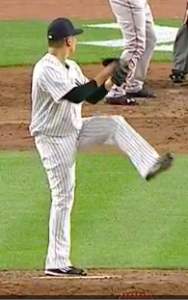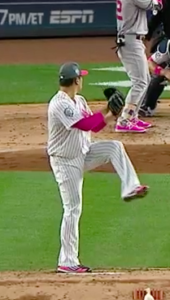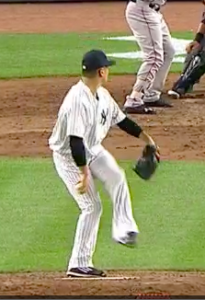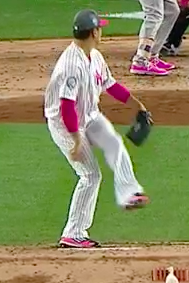Masahiro Tanaka Fails to Re2pect an Efficient Core

After an emotional first game of a double header and a pre game 2 ceremony in which Derek Jeter’s iconic number 2 was retired, the buzz in Yankee Stadium was electric. But all that seemed to fizzle fast when the Yankees’ Ace Masahiro Tanaka took the mound in game and got absolutely lit up. While I could easily write an article about how I think Jeter was a good but extremely overrated player, I think I got that out of my system in a group text with a bunch of my Yankee fan friends. Instead, I find Tanaka’s struggles way more interesting. (Editor’s note: Mike is wrong, Jeter is the greatest. Long live Number 2!)
And boy, did Tanaka struggle on Sunday. He has been pitching pretty poorly and inconsistently most of this season and he sandwiched two great starts in between a collection of mediocre to abominable appearances. When a player is that inconsistent there is one thing for which I immediately look: is he putting himself in a position for his core to fire efficiently?
If you have read any of my previous writing this may be starting to sound redundant. It’s something that is easy to miss if you aren’t looking for it. The pelvis and thorax should be in parallel planes and if a person were to stand, the thorax would be directly over the pelvis.While the pubic symphysis and xiphoid process are great landmarks to look at and for an athlete to be aware of, it can be difficult to see through a baseball jersey– we can compare the overall position of the ribcage to that of the pelvis as a realistic estimate of this.
This doesn’t have to remain throughout the entire delivery but it should be the starting point for an efficient and consistent delivery because it allows the core musculature to engage automatically, leading to increased proximal stability, which allows for distal mobility. If this concept sounds foreign I suggest reading this before you go ahead.
Masahiro Tanaka provides an excellent example of how a slight change, that is almost imperceivable, can lead to drastically different results. Let’s look at some freeze frames of Tanaka from Sunday’s start and one from last year year against the Red Sox in July. Both at-bats ended up in strikeouts (he can still succeed, just not as regularly), but the differences point to Tanaka’s ability to replicate the form consistently this year.
(Both photos courtesy of Major League Baseball)
In the shot on the left we see Tanaka pitching last year and on the right we see him on Sunday. He’s in an almost identical portion of his motion and not much looks different. However, if we really look closely we can see that he has a more neutral spine on the left that seems to be almost reaching for the sky with his ribcage directly over the pelvis, whereas on the right he seems a little more compressed with a slight extension in his mid-back (and even some possible side-bending/rotation – look at the difference in the wrinkles of his shirt). It is very subtle, but if you are looking for it, you can see it. It becomes even more obvious a little later in his motion:
(Both photos courtesy of Major League Baseball)
We can see that he appears to be leaning back slightly in the picture on the right, with his front shoulder slightly elevated compared to the back– his core hasn’t engaged nearly as well.
This could also be a reason that he has often been injured in his career – or a result of those past injuries. I’m willing to bet that something feels off in his body, but he is unsure what it is. Without examining him, it would be irresponsible for me to posit what exactly it is, but there is something off that isn’t allowing him to get into his proper alignment during his motion.
One of my physical therapy idols has a quote that I am going to paraphrase and probably butcher, but it goes something like this: “If your core hasn’t engaged in the first millisecond, start over.” While Tanaka can’t follow this advice during a game, unless he’s fine with balking on almost every pitch, it is something he should be working on between starts with the training staff and during throwing sessions. He isn’t broken, he is just missing a very important and often overlooked component of optimal movement. If he’s willing to wait a year until I get my license, I’ll gladly help him for a small fee.
-Mike Plude




















